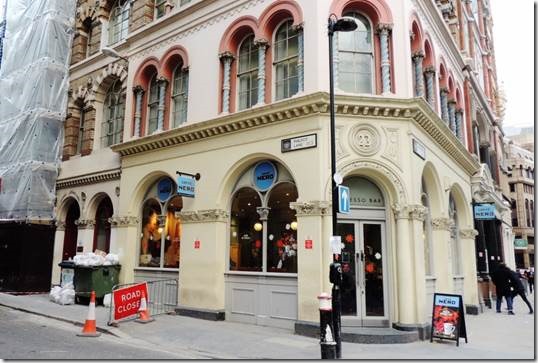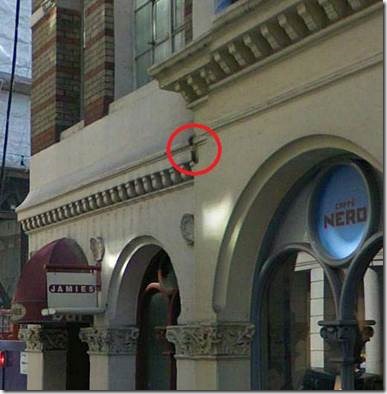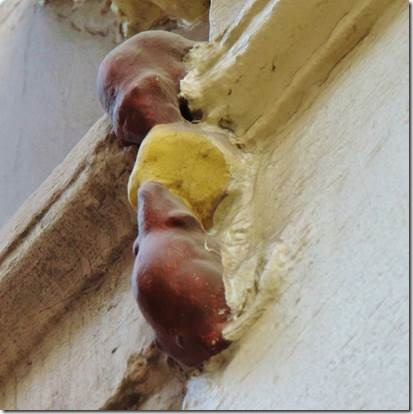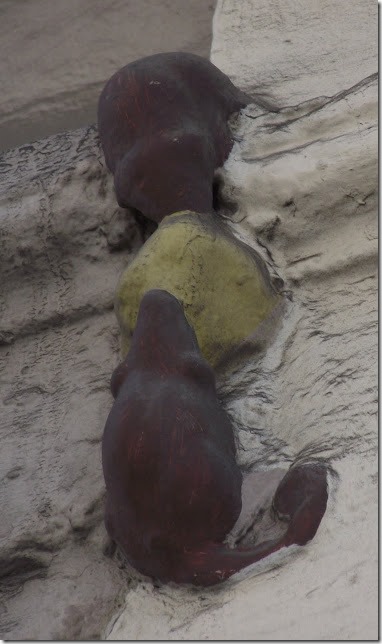Cheers,
While reading about The Monument to the Great Fire I’d read about the tiny mice sculpture not far from The Monument. Monday afternoon I went to find the “insect hotel” at St. Dunstan that I’d missed the first 2 visits and then to look for the two mice. I finally had the location; Philpot Lane off Cheapside, just near the Nero coffee shop. Lucky for me the construction just a bit further along on Philpot Lane was a bit further along Philpot Lane and not obscuring the tiny mice. However I’d never have found them had not a very kind bright green-jacketed city worker pointed them out to me. I could tell it was a treat for him to show me exactly where to look; they really are quite small. Luckily I didn’t say, “Good grief, they’ve made such a stir for being so tiny,” which was what I was thinking. But when he asked if I knew the story about the mice, I said yes. Later I could have kicked myself because, though I did know the story, it would have been such fun to hear him tell it. Fun for both of us. Next time I’ll pretend I don’t know the story and just enjoy the retelling. I actually had been in a hurry to get to the 3 Store to buy more internet time for Randal’s dongle, but I really am sorry I rushed off. After I’d taken my mice photos I went to find my “guide” to take his photo, but he had gone on to other tasks. So here’s the story of the mice.
Ru
“Not far from the northern end of London Bridge, in the capital’s historic centre, you’ll find a short street called ‘Philpot Lane.’
Named after Sir John Philpot (Lord Mayor of London (between 1378-1379), Philpot Lane links Eastcheap and Fenchurch Street.
It is also home to London’s tiniest public statue; ‘The Two Mice Eating Cheese.’
These two small fellows can be found half-way up a building which sits on the south-eastern corner of Philpot Lane, just by the junction with Eastcheap.
Details of who created these critters, and when they were placed here are pretty much non-existent. However, one thing is certain- these two wee mice are a memorial to two builders who died nearby…
The builders in question were working on ‘The Monument’; a towering column which stands on the junction of Fish Street Hill and Monument Street, about 400 ft. away from Philpot Lane. (The Great Fire Monument that I climbed.)
At some point during the Monument’s construction, the two builders mentioned earlier sat down to enjoy their packed-lunch of bread and cheese.
Clearly having a head for heights, the two men- who were sound friends by all accounts- were content to sit at their workplace; perched on a high scaffold (in those days of course, health and safety was unheard of. Workers on the Monument weren’t even required to wear hard-hats and hi-vis jackets!)
However, something was amiss… one of the men’s sarnies had been nibbled away to almost nothing!
What’s a Sarnie?
Sorry love, a sarnie is a British term for sandwich! Come on in and try our delicious sandwiches, soups and salads try our chips (crisps) and stay for a cookie (biscuit). http://www.jbsarnieshoppe.com/
For some reason, the victim of this food theft immediately blamed his mate sitting beside him and a fight broke out- not wise when you’re poised so high up.
Trading punches, the unfortunate pair lost their footing and plunged to the ground, both being killed instantly.
It was only later, after similar disappearances of bread and cheese, that the real culprits were discovered:
An infestation of tiny mice.
http://blackcablondon.wordpress.com/
|
23 Cheapside : Intersection of Philpot Lane (Left) and Cheapside (Right) “Up to the 12th century, for those living and working in the City of London, Cheapside (‘cheap’ meaning market) was the major of two markets and the names of the streets that lead off it reflect the trades that flourished there – Wood Street, Milk Street, Bread Street, Honey Lane, Poultry and Friday Street (for fish).” http://www.onenewchange.com/ One Poultry Place was part of our walking tour so more about that another time. It is also where the Boots optemetric shop is located and where I finally got my glasses put back together. |
|
Just past the Nero sign on Philpot Lane |
|
Very tiny indeed! And a very terrible recent paint job! Compare my photo I took today with the one below, you can see the lower mouse’s tail and the upper mouse’s leg and foot have been covered with white paint. The photo below was from a blog entry in 2011. |
|
“The mice are still fighting over a piece of cheese on the Philpot Lane side of 23 Eastcheap. They apparently date from 1862 when the building was constructed for the spice merchants Messrs Hunt & Crombie by John Young & Son. I can’t think of another piece of Victorian street art in London, so if the Bourchier Street Pig now claims the crown of smallest sculpture, perhaps the mice can go for the “Oldest Street Art” title instead.” |
|
http://www.peterberthoud.co.uk/2011/04/pig-on-a-tile-in-bourchier-street-2/ shows the small plastic pink pig that eventually disappeared so I really I don’t think it counts and the mice still win. |
|
And the mouse sculpture I haven’t yet seen…….. Further south, on a quiet stretch of the Thames Path near Rotherhithe, another rodent is easily overlooked. A menagerie of bronze animals ambles towards Surrey Docks Farm: there’s a family of pigs snuffling the ground, a fox prowling behind some waddling geese, and a couple of goats gazing blankly ahead, as goats always do. But, over on the Thames wall, there’s an odd little raised bump. On closer inspection, it becomes apparent that it’s not even big enough for a bump; it’s more of a blip. It’s a perfectly modelled bronze mouse. http://smokealondonpeculiar.co.uk/ Public Art Among the hidden delights of the area along the riverside or by the ponds in the Surrey Docks is a charming series of sculptures by established artists, commissioned by the LDDC and each specifically linked with the history or attractions of the area. At Cumberland Wharf, near the Mayflower pub, "The Bermondsey Lad and The Sunbeam Weekly", a series of three bronze figures – a Pilgrim Father, a small boy and a bull terrier – by Peter McLean refers to the Pilgrim Fathers who set sail for the New World from here in 1620. Philip Bews’ Deal Porters at Canada Water recalls the agile men who unloaded deal (timber) from the ships in the local docks while on the top of Stave Hill a Bas Relief by Michael Rizzello depicts the Surrey Commercial Docks as they were in 1896 – after a shower of rain the "docks" fill with water. At Barnards Wharf a cavalcade of farmyard animals by a variety of artists including pigs, a donkey, goats, geese, an owl and a mouse parades along the riverside towards Surrey Docks Urban Farm. |




